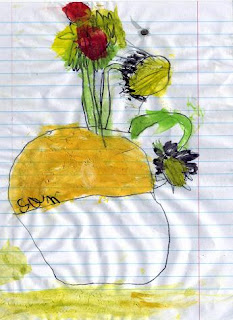 We've been enjoying beautiful weather here in North Cheshire in February so far. The skies have been clear, resulting in frosty nights and warm sunny days.
We've been enjoying beautiful weather here in North Cheshire in February so far. The skies have been clear, resulting in frosty nights and warm sunny days.Any time now my honeybees should start emerging from the hive to collect nectar from crocuses and other early flowers, and the queens should start laying eggs again.
Bumblebees too will soon be emerging. You'll first notice a small number of huge fat bumblebees - these are the queens, the only bumblebees that survive the winter. Unlike honeyebees, they truly hibernate, and then emerge in February to feed on nectar and find a nesting site. In late February or early March you'll notice a new flush of much smaller bumblebees. This is the new brood and they're scrawny and undersized because the poor old queen has had to feed them herself, and it's tough to collect enough nectar at this time of year to feed them up properly, especially when there's only one bee to do it. But the skinny first brood will feed the second brood, who will feed the third brood, and so on. By the time summer arrives you'll see lots of full-sized bumblebees buzzing about.
Bumblebees are great. They're very docile - you really have to work at it to annoy one enough for it to sting you. They're great pollinators, and if they like your garden you'll get more flowers, fruit and vegetables as a result of the work they do for you. They're cuddly fluffy little guys and I love them. If you'd like to encourage bumblebees in your garden, www.bumblebee.org has instructions for building nest boxes for them.
(I know it would have made sense to illustrate this blog post with a picture of a bumblebee, but I wanted to share this painting of Van Gogh's sunflowers that Sam did. He's only 6 and I'm very proud.)
9 comments:
Bumblebees are the cuddliest little fellas. I'm not great at buzzy things that fly in my face, but I find it hard to object to them.
Tell Sammy that Aunty Ninin is very proud, and Aunty Stephy is going to love his artwork!
Lindsey
I spend all summer catching bumblebees in the greenhouse and releasing them. I really should put a window in the further end - it never occurs to them (and why should it?) to turn round and fly back the way they came in.
FABULOUS picture, you should get it framed, unless it's felt tip, in which case it will fade to nothing in a few years. In which case, I wonder if photocopying would be a good plan, and keep the original somewhere dark.
Really great - you didn't need to tell us it was VG's sunflowers, instantly recognizable
Joanna
Tell Sam-Sam that Gangan is dead proud of him and loves his picture. A reward is winging its way to him as we speak.
My fiance would love to bees but right now we live in an apartment so we can't. In the meantime we purchase local honey and honey products.
Awww...love the picture (scan it to save it) and also love bumblebees. Found yr blog via Fake Plastic Fish and really like it. Thanks for writing!
Ummm.. great post.. My 3 1/2 year old wants to know.. How bees make honey out of Spit and Nectar.. Any idears?
Good question, Vicki's 2 1/2 year old. Nectar is a weak solution of sugar and water. In summer sometimes you can discover this for yourself - I remember when I was a child pulling the individual flowerets off red clovers and chewing the white end. Sometimes you get a burst of sweetness when you taste the nectar.
Bees collect the nectar and store it in their honey stomach, which is separated from its proper stomach by a little valve.
Bee spit contains enzymes which change the sucrose in the nectar into glucose and fructose. This starts before she ever gets back to the hive.
Back at the hive she will bring up the nectar mixed with enzymes into a cell. At this point it contains too much water, so it isn't honey yet.
In the warm ventilated environment of the hive, the excess water in the honey will evaporate. The bees fan with their wings to cause an air flow over the nectar to help take the moisture away.
When the water content is down to 18% (don't ask me how the bees know. I need a hygroscope to measure the water content of honey, but bees don't have hygroscopes) then the nectar has become honey. Actually beekeepers cheat. They don't normally use hygroscopes, they just rely on the bees to tell them when the honey is ready. The bees will cover the cell full of honey with a cap of wax, but only when the water content is lowered to 18%. When all the cells in a frame are capped, the beekeeper can take the frame away and extract the honey.
Do you like honey, Vicki's 2 1/2 year old? I do. I'm going to have some honey on waffles for my breakfast.
What a lovely drawing. Reminds me of one my eldest daughter did at about the same age only hers was of Edvard Munch's 'Scream'. I believe it's still in the loft somewhere. If only I could get up there I'd have a root around to see if found it and frame it for the kitchen wall.
We never get bumble bees in our garden but then I don't have a whole lot of flowers growing in my mud patch. Hopefully the garden will get sorted one day and they'll find it more attractive, cute little chaps that they are :)
Post a Comment